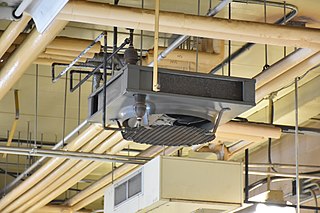
A corona is an aura of plasma that surrounds the Sun and other stars. The Sun's corona extends millions of kilometres into outer space and is most easily seen during a total solar eclipse, but it is also observable with a coronagraph. The word corona is a Latin word meaning "crown", from the Ancient Greek κορώνη.

A heat exchanger is a device used to transfer heat between two or more fluids. Heat exchangers are used in both cooling and heating processes. The fluids may be separated by a solid wall to prevent mixing or they may be in direct contact. They are widely used in space heating, refrigeration, air conditioning, power stations, chemical plants, petrochemical plants, petroleum refineries, natural-gas processing, and sewage treatment. The classic example of a heat exchanger is found in an internal combustion engine in which a circulating fluid known as engine coolant flows through radiator coils and air flows past the coils, which cools the coolant and heats the incoming air. Another example is the heat sink, which is a passive heat exchanger that transfers the heat generated by an electronic or a mechanical device to a fluid medium, often air or a liquid coolant.
Countercurrent exchange is a mechanism occurring in nature and mimicked in industry and engineering, in which there is a crossover of some property, usually heat or some chemical, between two flowing bodies flowing in opposite directions to each other. The flowing bodies can be liquids, gases, or even solid powders, or any combination of those. For example, in a distillation column, the vapors bubble up through the downward flowing liquid while exchanging both heat and mass.
Drone or drones may refer to:

A miniature snap-action switch, also trademarked and frequently known as a micro switch, is an electric switch that is actuated by very little physical force, through the use of a tipping-point mechanism, sometimes called an "over-center" mechanism.

A heat pipe is a heat-transfer device that combines the principles of both thermal conductivity and phase transition to effectively transfer heat between two solid interfaces.
Micro process engineering is the science of conducting chemical or
physical processes inside small volumina,
typically inside channels with diameters of less than 1 mm
(microchannels) or other structures with sub-millimeter dimensions.
These processes are usually carried out in continuous
flow mode, as opposed to batch production, allowing a throughput
high enough to make micro process engineering a tool for chemical
production. Micro process engineering is therefore not to be confused
with microchemistry, which deals with very small overall quantities of
matter.

Hydronics is the use of a liquid heat-transfer medium in heating and cooling systems. The working fluid is typically water, glycol, or mineral oil. Some of the oldest and most common examples are steam and hot-water radiators. Historically, in large-scale commercial buildings such as high-rise and campus facilities, a hydronic system may include both a chilled and a heated water loop, to provide for both heating and air conditioning. Chillers and cooling towers are used either separately or together as means to provide water cooling, while boilers heat water. A recent innovation is the chiller boiler system, which provides an efficient form of HVAC for homes and smaller commercial spaces.

Thermosiphon is a method of passive heat exchange, based on natural convection, which circulates a fluid without the necessity of a mechanical pump. Thermosiphoning is used for circulation of liquids and volatile gases in heating and cooling applications such as heat pumps, water heaters, boilers and furnaces. Thermosiphoning also occurs across air temperature gradients such as those utilized in a wood fire chimney or solar chimney.
A ground-coupled heat exchanger is an underground heat exchanger that can capture heat from and/or dissipate heat to the ground. They use the Earth's near constant subterranean temperature to warm or cool air or other fluids for residential, agricultural or industrial uses. If building air is blown through the heat exchanger for heat recovery ventilation, they are called earth tubes (also termed earth cooling tubes, earth warming tubes, earth-air heat exchangers, air-to-soil heat exchanger, earth channels, earth canals, earth-air tunnel systems, ground tube heat exchanger, hypocausts, subsoil heat exchangers, thermal labyrinths, underground air pipes, and others.

A geothermal heat pump or ground source heat pump (GSHP) is a central heating and/or cooling system that transfers heat to or from the ground.

In theaters, a batten is a long metal pipe suspended above the stage or audience from which lighting fixtures, theatrical scenery, and theater drapes and stage curtains may be hung. Battens that are located above a stage can usually be lowered to the stage or raised into a fly tower above the stage by a fly system.

A fan coil unit (FCU) is a simple device consisting of a heating and/or cooling heat exchanger or 'coil' and fan. It is part of an HVAC system found in residential, commercial, and industrial buildings. A fan coil unit is a diverse device sometimes using ductwork, and is used to control the temperature in the space where it is installed, or serve multiple spaces. It is controlled either by a manual on/off switch or by a thermostat, which controls the throughput of water to the heat exchanger using a control valve and/or the fan speed.
A direct exchange (DX) geothermal heat pump is a type of geothermal heat pump in which refrigerant circulates through copper tubing placed in the ground. It is a closed-loop, refrigerant-based geothermal system.

Radiators and convectors are heat exchangers designed to transfer thermal energy from one medium to another for the purpose of space heating.
The Glossary of Geothermal Heating and Cooling provides definitions of many terms used within the Geothermal heat pump industry. The terms in this glossary may be used by industry professionals, for education materials, and by the general public.

Gothic boxwood miniatures are very small Christian wood sculptures produced during the 15th and 16th centuries in the Low Countries, at the end of the Gothic period and during the emerging Northern Renaissance. They consist of highly intricate layers of reliefs often rendered to nearly microscopic level, and are made from boxwood, which has a fine grain and high density suitable for detailed micro-carving. There are around 150 surviving examples, a majority are spherical rosary beads, statuettes, skulls, or coffins; some 20 are in the form of polyptychs including triptych and diptych altarpieces, tabernacles and monstrances. The polyptychs are typically 10–13 cm in height. Most of the beads are 10–15 cm in diameter and designed so they could be held in the palm of a hand during personal devotion or hung from necklaces or belts as fashionable accessories.

Leroy Stevenson (Skipp) Fletcher is an American mechanical and aerospace engineer, and college dean, who served as the 104th president of the American Society of Mechanical Engineers in 1985-86, and was recipient of the 2002 ASME Medal.












